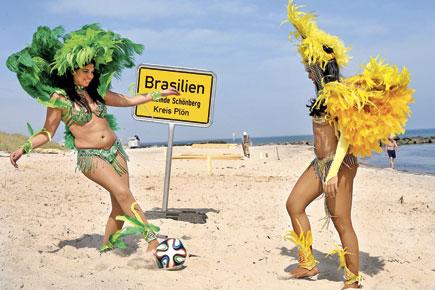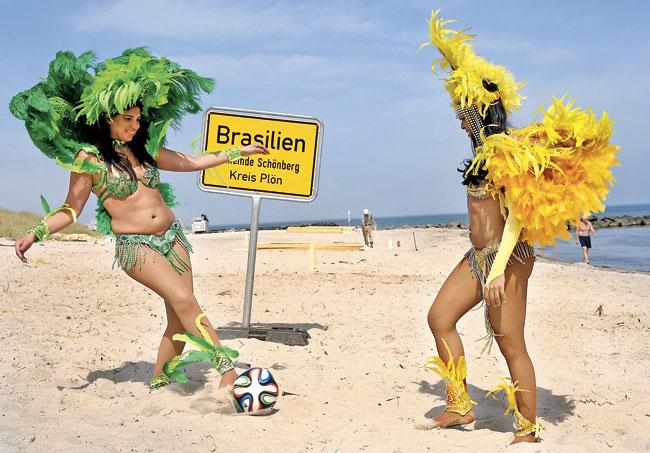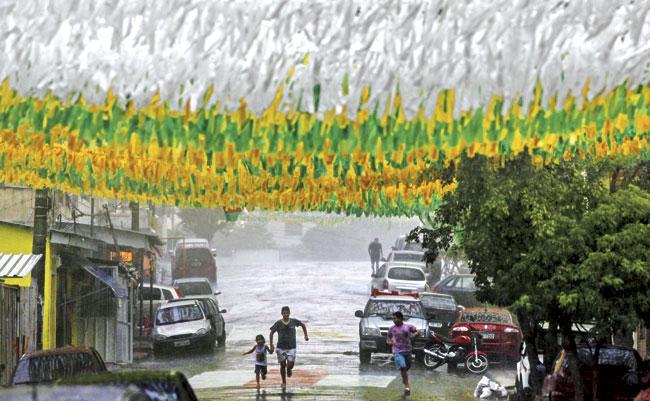With football enthusiasts devouring media reportage about the World Cup greedily, television screens satiating the appetite for news, the greatest sporting show on earth has begun in the land of Samba

With football enthusiasts devouring media reportage about the World Cup greedily, television screens satiating the appetite for news and views about megastars, the greatest sporting show on earth, the FIFA World Cup has begun in the land of Samba, sun and surf, which is Brazil.

Brazilian dancers Luciana (L) and Simone play football on the beach. Pics/AFP
ADVERTISEMENT
I, meanwhile, am caught up in a time warp of my own. Walk down memory lane with me, as I remember my tour of Brazil, way back in 1997 with Travcoa, of California. It may have been a while since I visited the South American nation, but memories still cling to me like dew on a leaf.

People take cover from the rain under the decorations at Santa Isabel Street in Manaus one of the host cities of the World Cup
High five
Out of the 12 cities that Brazil has chosen for the matches, I have been to five of them and of course, the spectacular Foz da Iguacu. The five are: Manaus, Salvador de Bahia, Belo Horizonte, Foz do Iguazu, Brazilia and Rio de Janeiro.
Manaus memories
Let me start with the charming town of Manaus in the North, located on the River Negro (Black, because its waters are muddy and black) and parallel to it is the white water River Solimoes, the point where both merge and become the mighty Amazon.

The statue of the Christ the Redeemer is seen lit with the colours of the Brazilian flag during the changing of all 32 nations' colours participating in the World Cup
Manaus made much money because of the rubber boom in the late 19th century and even today many colonial style buildings, and, old neo-classical architecture is visible. The finest example of this is the Manaus Opera House, which still offers musical concerts and grand opera, a gift from a philanthropist.
Rich rainforests
Tourism thrives mainly from cruise ships that ply different parts of the Amazon. My three-day trip across these rich rainforest jungles introduced me to the diverse flora, fauna and caboclo homes of local tribals, around river banks.

A fan holds the South Korean flag as she welcomes the team at the Bourbon Hotel in Foz da Iguacu
Every day brought me to a new location, like the giant water lily pads, ever so refreshing with their opened blooms, gigantic ant hills, certain trees, whose branches held hidden water which helped people lost in the jungle. Incredibly, the boat staff armed with fishing rods caught many baby piranhas, whose teeth were as sharp as adults. Later, we had them barbequed over a picnic lunch.
River bound
The nights found us going down river, with spotlights, seeking out the caimans, which are from the crocodile family, but much smaller, with ruby red eyes that sparkled against our torches. We also spotted the largest river snake, the 'anaconda', poisonous frogs and plants, gentle dolphins, the sea cow known as manatee and other aquatic species, which included the absolutely terrifying Toothpick Fish.
This is a slender catfish variety called 'Candiru' which swimmers encountered if they were not careful. It would enter through the vagina or anus opening and immediately open up its spikes which latched onto membranes and swelled out so much, that they were impossible to disgorge, except through an expensive and painful surgery.
One of my most memorable meals was feasting on the giant spare ribs of Manaus' tastiest fish, The 'Tambaqui'. Leaving the water and coming back to terra firma, I remember within the city, while walking around the Mercato, I met up with several Gujarati traders from Bulsar, dealing in electronic goods. Their eyes popped out to hear me converse with them in Gujarati. Home seemed so close at that moment.
Heritage call
Our next port of call was Salvadore de Bahia named after the bay it encircles on the Atlantic Coast. It is one of the earliest cities in all of the Americas and is a famous Unesco World Heritage Site.
This very energising city has retained most of its African roots, right from its religion Candomble with its deep rooted cults and rituals, its distinctive food, dance and music, (best seen during the Carnival frenzy) and its Capoeira, which a graceful form of martial arts. It created its wealth with exports of sugarcane, tobacco, gold and diamonds, and imported African slaves to work in vast plantations.
Walk around
To see Bahia at its best, one needs to walk around the many squares because each has a unique flavour. A steep cliff divides the Ciadade Alta (upper city) and the Ciadade Baixa (lower city). Access to both can be by a steep funicular or by electric elevators, with sweeping harbour views from above.
The squares see a throng of vendors, tourists and fascinating locals. The upper city has a rich heritage of baroque style architecture, best seen in Cathedral Basilica with its exceptional ceiling and artistic decor, extended to several churches where gold leaf covered altar pieces can be seen and various baroque styles are displayed in museums dotting the city.
The women
As soon as you arrive onto the upper city, you will be surrounded by the Bahianas, broad hipped women dressed in beautiful white gowns and turbanned caps with a lot of accessories around their necks. They come to persuade you to try their cooking, an assortment of sugared and spiced fried balls (acaraje, which is brown beans mashed in salt and onions, fried in dende palm oil with stuffing of various kinds). Most popular dishes are seafood stews. Then there is vatapa, using ingredients like coconut, shrimps, dende oil and manioc. But it is the memory of their music and revelry, that I carry away with me.
Gold shine
With that music still ringing in my ears, I come to Bella Horizonte, the sprawling capital of Minas Gerais, the site of the Gold Rush which at one time was the largest producer of gold from all over the world and amazing varieties of precious gemstones from aquamarines, tourmalines, amethysts to topaz and more, were mined here.
My actual destination was for the typically colonial town of Ouro Preto (interpreted as Black Gold), which is 87 km away. It is home to outstanding baroque architecture and the brilliant sacred sculptures of Brazil's world famous artist, Aleijadinho, to whose works an entire museum is devoted.
Here, a word about this sculptor as taken from the Lonely Planet. I quote: "a son of a Portuguese architect and an African slave, he lost the use of his arms and legs at the age of 30 but with a hammer and chisel strapped to his arms, he advanced art in Brazil from the excesses of Baroque, to a graceful more finer Rococo" unquote.
Falls call
I am shifting my focus from man made wonders to the spectacular beauty of the Cataracts of the Foz da Iguacu. A long unending line of 275 different gushing milky falls, surrounded by the mist it creates when the River Iguacu plunges downwards 80m.
The pilot made a complete aerial round of the Foz Da Iguacu, providing one unforgettable views from several angles before he touched down on the runway. However, to get the best views of the Foz Da Iguacu, one must cross over to the Argentinian side.
Carrying a raincoat is essential. I stayed one night at a sprawling hotel on the Brazilian side, just across the Foz Da Iguacu. Through the night, the deafening roar of the Foz Da Iguacu was a reminder of its force and might.
Modern architecture
On both sides of the Foz Da Iguacu, was a souvenir-scouting tourists' paradise, boutiques burst open with gemstone artifacts, to hand made souvenirs and a wealth of picture postcards. The stunning beauty comes with one caveat though, be wary of pickpockets all through the visit.
Coming to Brasilia, the present capital of Brazil, located in the Central Highlands. This World Heritage Site, is a masterpiece of modernist architecture and abounds in buildings of great grandeur and design. This city was the joint vision of Brazil’s late President Juscelino Kubitschek and the outstanding architect, Oscar Niemeyar.
The best way to explore all its tourist attractions would be to take the organised bus tour. It is designed in the shape of a giant bird or likened to an airplane. The most important buildings are to be found in the Monumental Axis, the Three Power Square, comprising The Presidential Palace, The Congress and The Supreme Court.
There is also an elegant memorial monument to the late visionary President. Pasanoa, an artificial lake, provides the people with recreational activities, walking paths and lakeside restaurants. To top it all the city's breathing lungs are a shade bigger than New York's Central Park.
Carnival flavour
This effervescent city built on Rio de Janeiro, has wooed hordes with its Bachanalian Carnival during Mardi Gras, when trucks of musicians roll out for the mesmerizing Samba Parade. Thousands of colourfully dressed dancers weave in and out along the streets, stirring the frenzied crowd. The locals, called 'cariocas' are full of rhythm and any excuse is good enough to party.
The beaches are thronged with sun worshippers and some have had songs dedicated to them, like the famous, "Girl from Ipanema" and the darling of the masses, the one and only Carmen Miranda, from the '30s to the '50s, with her large turbanned hats spilling over with baskets of dangling fruits and flowers as she trills and sways to Aye Aye Aye Aye Like you Very Much and Chica Chica Bum Chic.
An absolute must on your sightseeing list should be a visit to a museum dedicated solely to her. World famous sights of Rio include the towering 710m statue of Christ the Redeemer atop the Corcovado Mountain, the Pao da Avacar Sugar Loaf Mountain, the nearby lush green rain forest in the Park National da Tijaca (reachable by a cog railway) and the glimmering Guanabaro Bay below.
Ceremony scene
Around this area hidden from many, in 1970, during my first visit, I saw the locals performing a 'Sacred Macumba Ceremony' where a rooster was killed amidst much chanting and shrill singing, spirits were called as several participants fell into a trance.
Then, of course, Rio has its other side too, its Casa Rosa once a famous Red Light Area and today a well known nightspot. Behind this veil of pomp there are Favelas (shanty towns) around steep hillsides and the penury around it.
Yet, the cariocas are one happy lot and the word 'FUTBAL' turns them into daredevils. These glimpses of Brazil, were meant to titillate my armchair travellers and stir them to discover the magic of Brazil, as the famous song goes 'Your Way'!
The writer is an intrepid traveller. She has visited 180 countries to date. She believes the world is her oyster and one must keep travelling to find the pearl of wisdom inside.
 Subscribe today by clicking the link and stay updated with the latest news!" Click here!
Subscribe today by clicking the link and stay updated with the latest news!" Click here!







